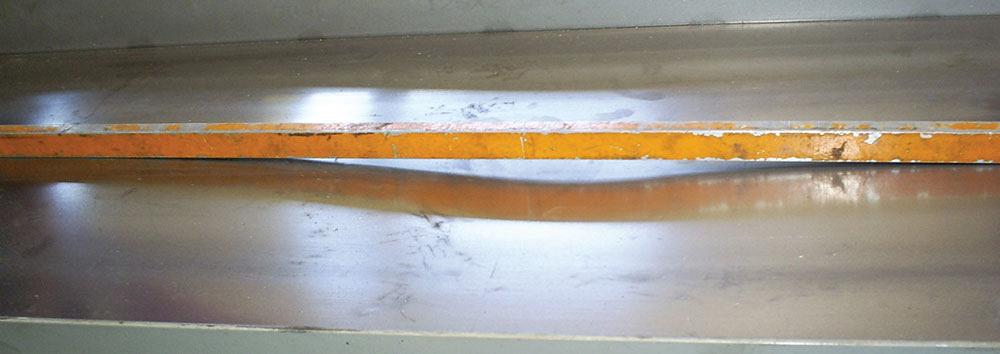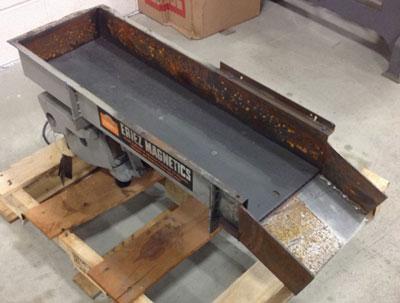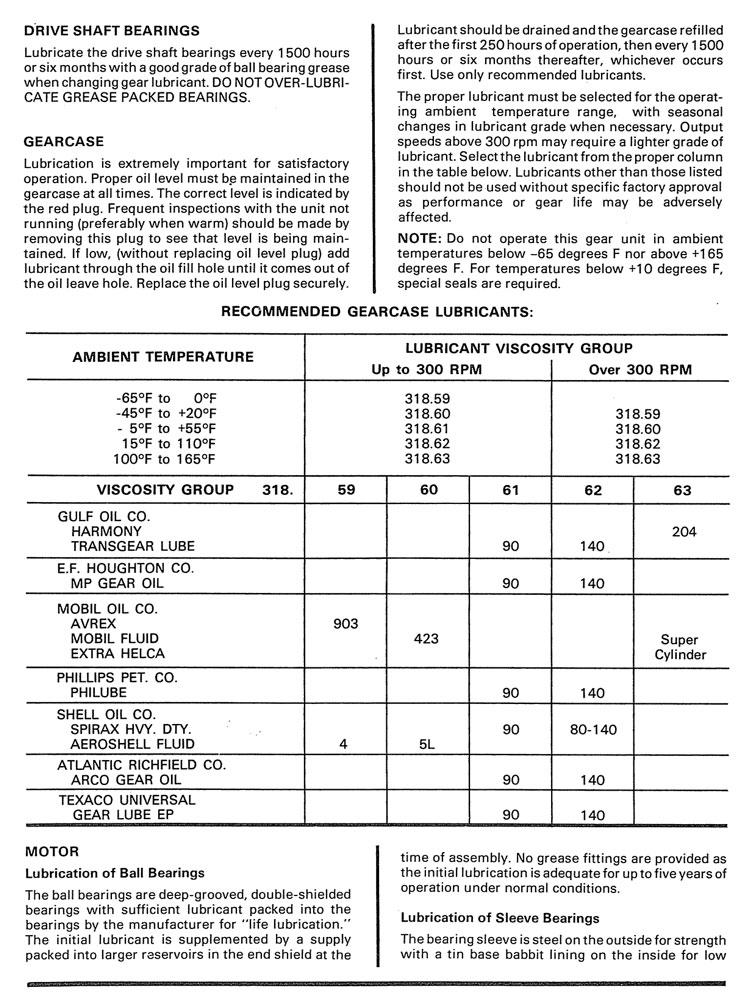Remanufacturing Services Manager
- FMA
- The Fabricator
- FABTECH
- Canadian Metalworking
Categories
- Additive Manufacturing
- Aluminum Welding
- Arc Welding
- Assembly and Joining
- Automation and Robotics
- Bending and Forming
- Consumables
- Cutting and Weld Prep
- Electric Vehicles
- En Español
- Finishing
- Hydroforming
- Laser Cutting
- Laser Welding
- Machining
- Manufacturing Software
- Materials Handling
- Metals/Materials
- Oxyfuel Cutting
- Plasma Cutting
- Power Tools
- Punching and Other Holemaking
- Roll Forming
- Safety
- Sawing
- Shearing
- Shop Management
- Testing and Measuring
- Tube and Pipe Fabrication
- Tube and Pipe Production
- Waterjet Cutting
Industry Directory
Webcasts
Podcasts
FAB 40
Advertise
Subscribe
Account Login
Search
5 FAQs about keeping conveyors running smoothly
Check critical components for optimal operation
- By Eric Taylor
- March 10, 2014
- Article
- Materials Handling

Conveyor tracks, (pictured), belts, bearings, and other critical components require vigilant inspection and attention to wear and damage.
There was a time when companies’ repair and preventive maintenance (PM) departments had full crews with ample time and resources to check all the presses, tooling, and material handling equipment, such as conveyors, on a regular basis. Today many stamping manufacturers have to get by with smaller teams made up of individuals who must juggle a multitude of responsibilities throughout the facility.
The task of inspecting conveyors and monitoring maintenance needs often falls to you, the operator. Working in the trenches, you have great familiarity with the equipment and understand how it acts, looks, and sounds when it’s functioning at peak performance and when it’s not.
The following frequently asked questions (FAQs), can help ensure that conveyor systems on your watch run smoothly—and you’ll know when to spot potential problems that may require the attention of maintenance personnel.
1. Which components tend to wear out fastest, and which need the most attention?
Bearings. Bearings are often the first things to show wear. This is frequently due to heat. If a bearing is hot to the touch—certainly if it’s glowing—that is a red flag that it needs maintenance. If you don’t see any grease around a bearing, that would be a sign that it needs greasing or may have already failed.
Motor cover. Make sure it is not restricted; if it is, clear it of dirt or pieces of scrap.
Air compressor. You want to be sure you have clean, dry air. When air is compressed, it produces moisture. Sometimes that flows into motors and damages them.
Belt. If you have a belt conveyor, check the belt for the presence of jammed scrap pieces. Also check that the correct belt/chain tension is maintained.
Magnetic conveyor slider bed. Listen for a thumping sound. The magnets travel beneath the slider bed. Sometimes those magnets will encounter a dip or dent repeatedly. The face of the conveyor may be pushed down, which can reduce the clearance between the magnet and the underside of the slider bed. When there’s not enough space, the magnets start hitting and you’ll hear a thump.
Laying a long straight edge lengthwise along the bed will make indentations visible (see Figure 1).
Sometimes a worker accidentally drops a tool or a part on it or steps on it. Seeing a bootprint where the magnet hit the slider is not unusual. It’s happened!

Figure 1
One way to check the levelness of a magnetic conveyor slider bed is to lay a straight
edge on it. Dips and dents decrease the clearance between the bed and the magnets
underneath, causing the magnets to collide with the bed.
If you put your hand on the slider bed, you may feel it hitting. The stamping press does not have to be running to perform this check, but the conveyor has to be operational. You can touch the slider near the discharge end, where it’s clear from any moving parts. If you’re getting a hit inside a conveyor housing, you should be able to feel it at the discharge end of the conveyor where you’re not going to jeopardize your safety.
Sometimes the slider bed of a magnetic conveyor actually bows up. This increases the air gap between the magnet face. As a result the material and the conveyor won’t move as much material. That is mostly caused by an impact that pushes down into the magnet.
Magnets. The magnet itself is in a stainless steel cover. Eventually the cover will wear through and the magnet pieces will come out and jam up the conveyor so it doesn’t work at all. An indentation on the conveyor surface is an indication that you better take off the inspection panel and look to see if the magnets are damaged, marked up, or nicked severely.
Motor. If a motor is excessively hot, it should be replaced. A working motor should be warm. As for what temperature is right, they’re all rated differently. You can find the rating for your particular equipment in the operations manual you received from the manufacturer.
If you’re tuned in to how the machine is running, usually you’ll be able to tell if it’s not running right. Even with your hearing protection, you may hear something or feel vibration.
When something breaks, it’s too late. Unfortunately, most of the time a motor just fails without warning. If it’s going to burn out, there is no preventing it. However, you may be able to smell when a motor is burning out. A motor burnout creates less downtime if you notice it right away. By taking quick action you can ensure your scrap doesn’t build up, parts don’t get crushed, and you don’t ruin a die. Unless it’s a very big motor, it should be replaced.
2. How often should I inspect conveyor systems?
You should inspect certain basic components at the beginning and end of a shift. Walk around the equipment and look for anything that might be amiss, listen for funny noises, and look at the condition of the components of the basic parts that are running all the time (see Figure 2).
3. Where in a conveyor can I achieve energy efficiencies with a retrofit?
Replacing an older motor with a newer, energy-efficient model is the best way to reduce energy usage. You should also be sure to clean the oil and gear lube. Doing so will make it run more energy-efficiently. You can increase a magnetic conveyor’s pulling power by upgrading the magnets.
4. How do I know when to rebuild or when to replace?
Each company has its own threshold as to when to replace a conveyor system, and it’s primarily based on cost. For some, if the cost to repair is 60 percent of a replacement, that is the threshold. Sometimes the threshold is as high as 70 percent of the cost of a new one.
Other times it’s a lead-time issue. A conveyor that can be repaired in two weeks may be more attractive than a new one that takes six weeks for delivery. Sometimes the decision is based on whether the cost can be taken out of a repair budget or a capital equipment budget.

Figure 2
A discharge chute connected to a feeder
adds excess weight to the tray, causing
inconsistent feed and damage.
5. Should I ignore the manual?
No! (OK, this is not a frequently asked question.)
Keep the conveyor manufacturer’s installation/operation manual in a secure location and refer to it for the appropriate maintenance schedule for your equipment. This lays out proper inspection procedures and offers important information, such as how long a component in the conveyor system should last.
Change the gear lube and gear reducer every six months. There are certain oil types that you need to use on the components. Anything pertinent to the equipment operation—such as MSDS for oils—is included in your manual (see Figure 3).
Obviously, if you do your maintenance along the way, you’ll have a better chance of running your operation optimally.
About the Author
Eric Taylor
2200 Asbury Road
Erie, PA 16506
814-835-6000
subscribe now

The Fabricator is North America's leading magazine for the metal forming and fabricating industry. The magazine delivers the news, technical articles, and case histories that enable fabricators to do their jobs more efficiently. The Fabricator has served the industry since 1970.
start your free subscription- Stay connected from anywhere

Easily access valuable industry resources now with full access to the digital edition of The Fabricator.

Easily access valuable industry resources now with full access to the digital edition of The Welder.

Easily access valuable industry resources now with full access to the digital edition of The Tube and Pipe Journal.
- Podcasting
- Podcast:
- The Fabricator Podcast
- Published:
- 04/16/2024
- Running Time:
- 63:29
In this episode of The Fabricator Podcast, Caleb Chamberlain, co-founder and CEO of OSH Cut, discusses his company’s...
- Trending Articles
How to set a press brake backgauge manually

Capturing, recording equipment inspection data for FMEA

Tips for creating sheet metal tubes with perforations

Are two heads better than one in fiber laser cutting?

Hypertherm Associates implements Rapyuta Robotics AMRs in warehouse

- Industry Events
16th Annual Safety Conference
- April 30 - May 1, 2024
- Elgin,
Pipe and Tube Conference
- May 21 - 22, 2024
- Omaha, NE
World-Class Roll Forming Workshop
- June 5 - 6, 2024
- Louisville, KY
Advanced Laser Application Workshop
- June 25 - 27, 2024
- Novi, MI



























